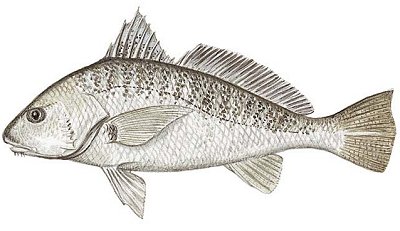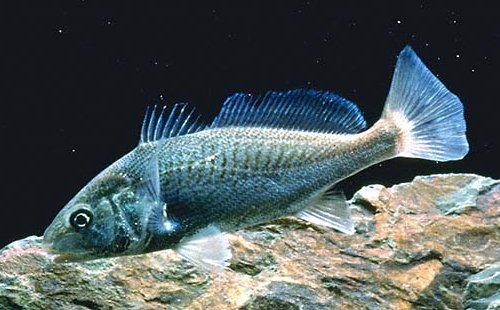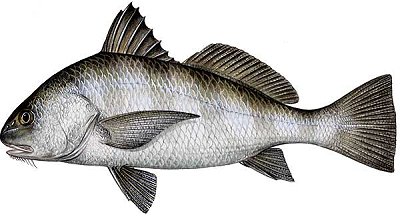Atlantic Croaker

Micropogonias undulatus
Profile by John McClain, Principal Fisheries Biologist
The croaker is a member of the Sciaenidae, or drum family, which includes the black drum and weakfish. Their name comes from the sound they can make by vibrating their swim bladders.
Names:
The accepted scientific and common names are Micropogonias undulatus and Atlantic Croaker. Other common names are croaker, golden croaker, and hardhead.
Size:
The largest Atlantic croaker reported was 26 inches in length and weighed 8 pounds, cleaned. The New Jersey State record is a 5.5-pound fish caught in Delaware Bay in 1981. The average croaker kept by fishermen in New Jersey in recent years ranges from 11 to 14 inches.
Food:
The Atlantic croaker is an "opportunistic bottom-feeding carnivore" which means it will eat any small shellfish, worm, crab, shrimp, etc, it can catch. In turn, croakers are eaten by larger predators such as bluefish, striped bass, summer flounder, weakfish, and sharks.
Range And Migration:
The Atlantic croaker occurs in Atlantic coastal waters from Cape Cod, Massachusetts to Florida and through the Gulf of Mexico. While uncommon north of New Jersey, they are one of the most abundant inshore bottom-dwelling fish from the Chesapeake south through the Gulf of Mexico. Their appearance in our waters is dependent on favorable environmental conditions and/or high population numbers. When conditions have been favorable, adult croakers move into Delaware Bay and our coastal waters in early summer. They begin moving south and somewhat offshore in mid-fall.
Spawning:
Atlantic Croaker spawn offshore from September through December between Cape May and North Carolina. Further south, the spawning season extends into March. Most croakers are mature by age three. Females can release from 100,000 to 1.5 million eggs depending on fish size. The young move into the larger bays and upriver after spawning where they appear to overwinter. Young croakers ranging from less than 1 inch to 2 inches have been taken in the Delaware River in November and December. This tendency may account in part for the variability in croaker abundance. Studies indicate that winter water temperatures in the mid-Atlantic estuaries greatly affect the number of croakers in the mid-Atlantic region. The survival rate for young of the year Atlantic croaker is less than two percent at temperatures below 38°F. Severe winters can result in the loss of most of a year class of overwintering fish.

Commercial And Recreational Importance:
Commercial landings in New Jersey have varied widely over time, from 100 pounds in 1971 to 2.1 million pounds in 2000. Most of the harvest is taken from August through October by the otter trawl fishery in the southern portion of the state. However, gill net landings have increased in the last few years, going from less than one percent of the landings in 1997 to 30% in 2000. The Marine Recreational Fisheries Statistics Survey reported no New Jersey landings from 1982 through 1990 and for 1992. A few fish were taken in 1991 and reported landings since then have increased drastically from 2500 fish in 1993 to 990,000 fish in 2000. The fishery occurs primarily in our southern coastal waters and Delaware Bay.
Sportfishing Techniques:
Atlantic Croaker are caught from July through October by private, party, and to a lesser extent, charter boats. Most are taken in the ocean, although bay catches have been increasing. Croaker are caught using top and bottom rigs, single hook rigs, bucktails, and jigs. Baits used are shrimp, worms, shedder crab, fish, squid, and soft plastic lures. Since croakers are bottom feeders, enough weight must be used to keep the bait close to the bottom.
References:
Lankford, T. E. Jr. and T.E. Targett, 2001
Unpublished manuscript
Personal communication from the National Marine Fisheries Services, Fisheries
Statistics and Economics Division, Silver Spring, Maryland
This article first appeared in New Jersey Fish & Wildlife Digest - 2002 Marine edition
Black Drum is similar and related, but typically much larger.

